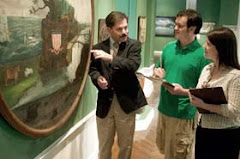Reverse painting on glass has a luminous effect that is very enjoyable to behold. The brush strokes are so smooth against the surface and the play of light as it reflects on and through the glass brings out the color in ways that canvas or paper cannot. The really fascinating thing about this art form is that the artist had to do the painting in reverse, painting the highlights first and the base coats last; just the opposite of how most artists learn to paint.
Not much is know about Greenleaf. He was born in Hull in 1769, married in 1799, and died in 1821. He lived in Dorchester and painted portraits in Eastern Massachusetts, New Hampshire, and Maine. There are a few dozen of his works known, most of which are on glass as this one is. I've always been partial to our portrait of the 74-year-old Lydia Waterman in her white bonnet with her matter-of-fact expression. That the artist was able to capture her personality so well in such a demanding medium makes this a real masterpiece, and the fact of its fragility makes it a remarkable survival as well.












